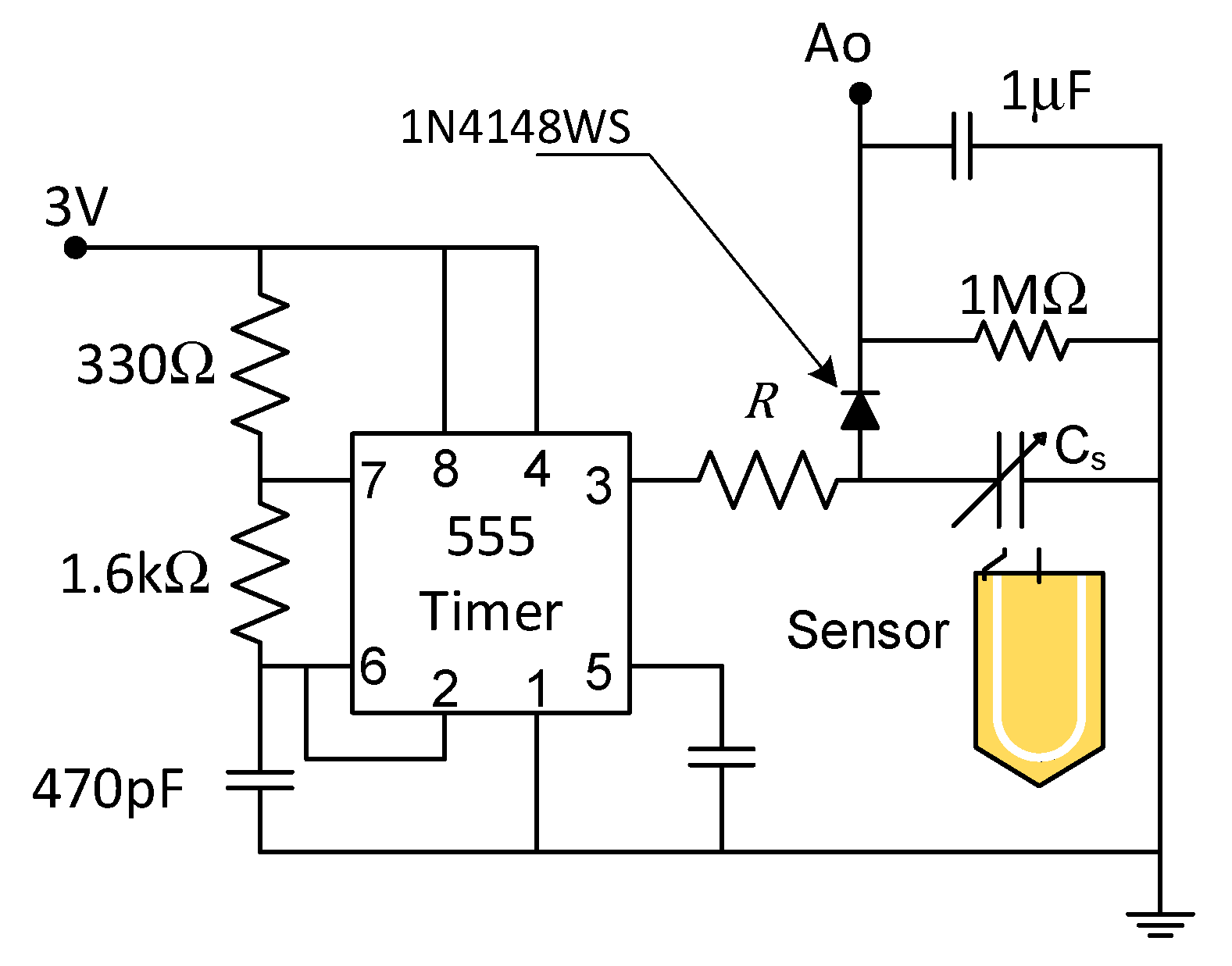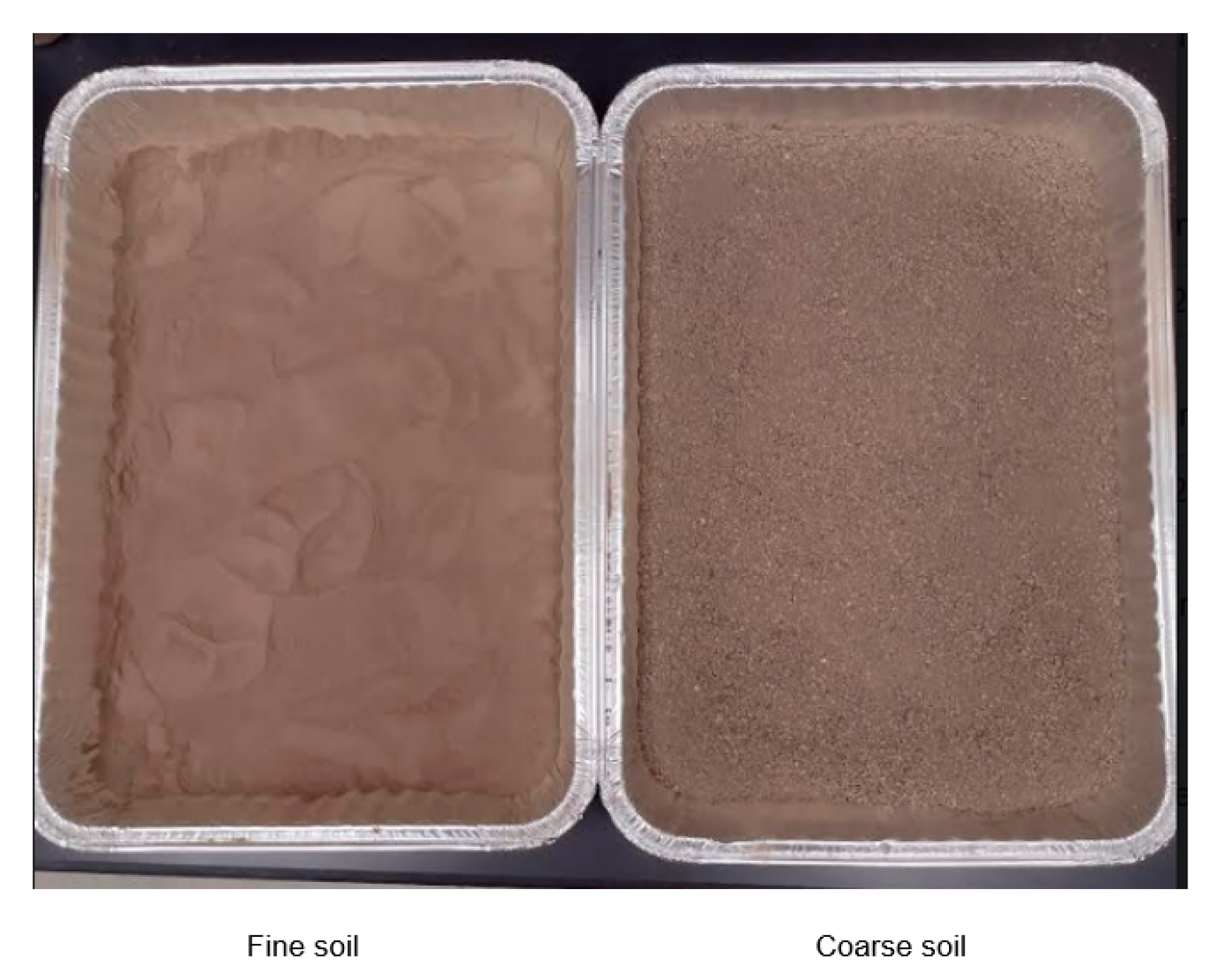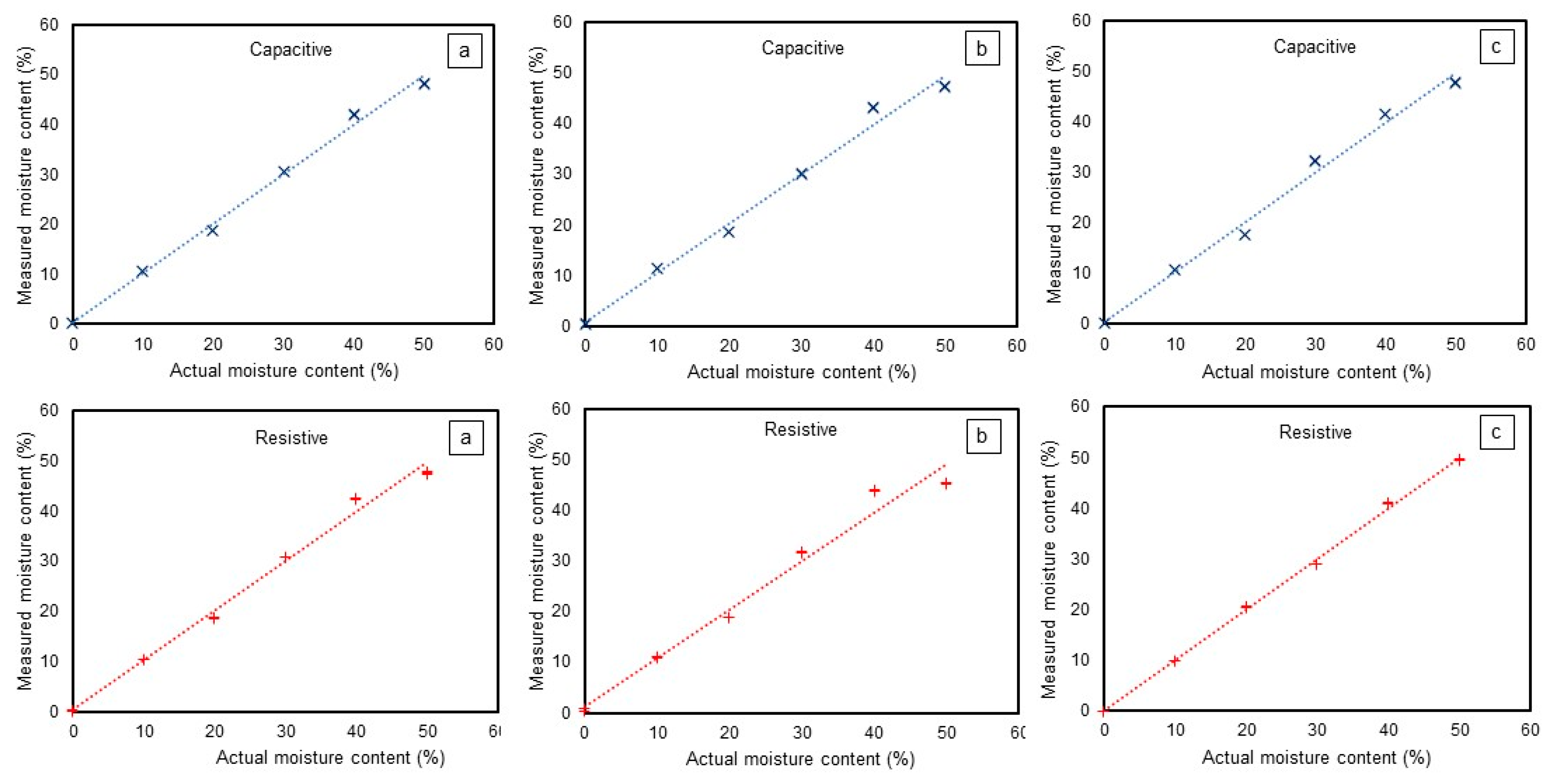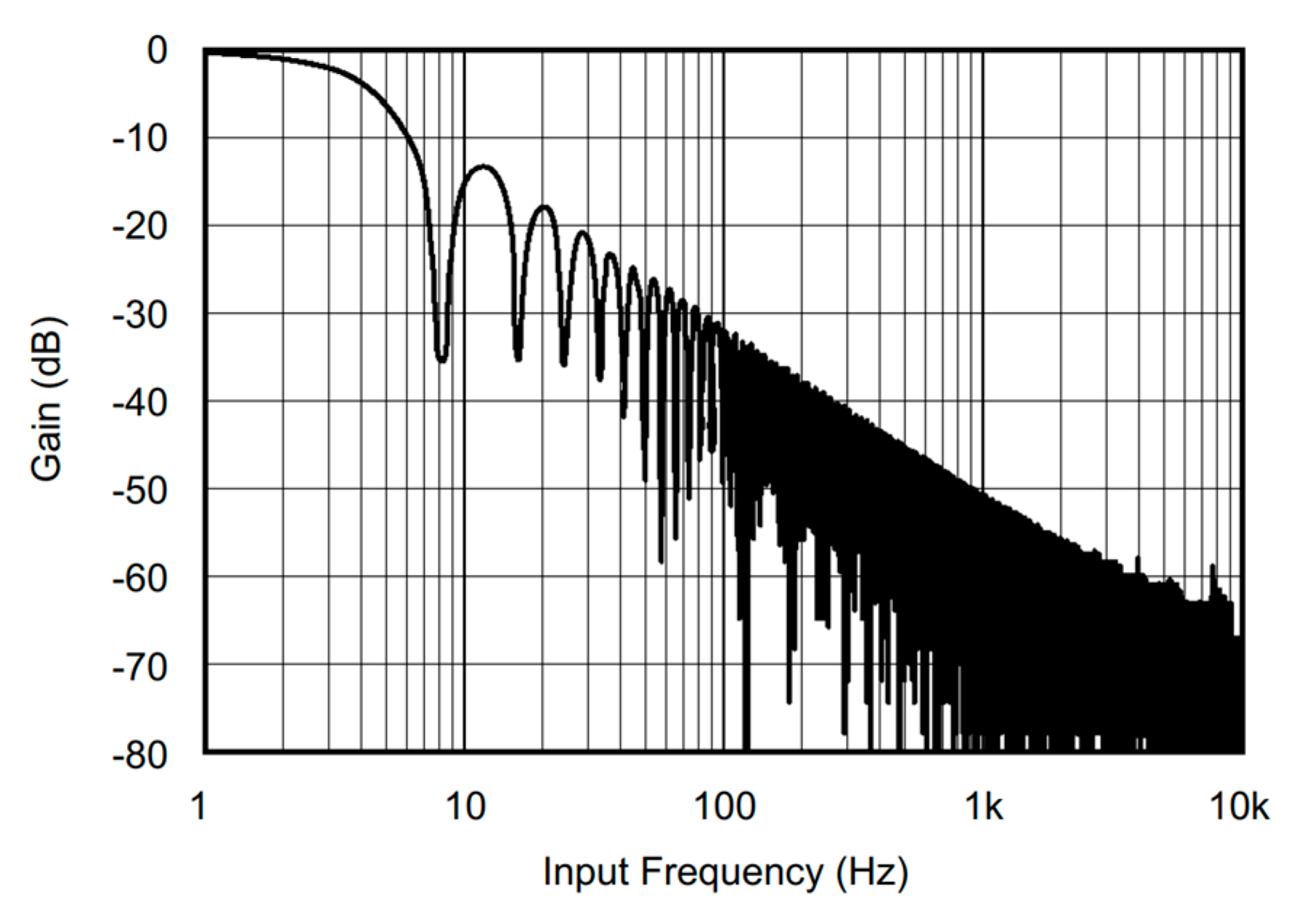Assessment of Low-Cost and Higher-End Soil Moisture Sensors across Various Moisture Ranges and Soil Textures
Abstract
:1. Introduction
2. Materials and Methods
2.1. Soil Moisture Sensors
2.1.1. Low-Cost Resistive Sensor
2.1.2. Low-Cost Capacitive Sensor
2.1.3. VH400 Moisture Sensor
2.1.4. 5TM Moisture Sensor
2.2. Signal Stability Improvement Using an ADC
2.3. Sample Collection and Preparation
2.4. Measurement of Soil Bulk Density
2.5. Experimental Setup
2.6. Experimental Procedure
2.7. Data Analysis
3. Results
3.1. Performance Comparison without ADS1115
3.2. Performance Comparison with ADS1115
4. Conclusions
Author Contributions
Funding
Data Availability Statement
Acknowledgments
Conflicts of Interest
References
- Pan, B.; Xia, L.; Lam, S.K.; Wang, E.; Zhang, Y.; Mosier, A.; Chen, D. A Global Synthesis of Soil Denitrification: Driving Factors and Mitigation Strategies. Agric. Ecosyst. Environ. 2022, 327, 107850. [Google Scholar] [CrossRef]
- Davidson, E.A. Fluxes of Nitrous Oxide and Nitric Oxide from Terrestrial Ecosystems. In Microbial Production and Consumption of Greenhouse Gases: Methane, Nitrogen Oxide, and Halomethanes; Rogers, J.E., Whitman, W.B., Eds.; ASM Press: Washington, DC, USA, 1991; pp. 219–235. [Google Scholar]
- IPCC. IPCC Second Assessment Report: Climate Change 1995 (SAR)—Working Group I: The Science of Climate Change; IPCC: New York, NY, USA, 1996. [Google Scholar]
- NRCS. Irrigation Water Management. In National Engineering Handbook: Irrigation Guide; NRCS, Ed.; United States Department of Agriculture: Washington, DC, USA, 1997; pp. 9.1–9.223. [Google Scholar]
- UNESCO. Executive Summary. In Water for Prosperity and Peace; United Nations Educational, Scientific and Cultural Organization: Paris, France, 2024; pp. 1–8. ISBN 9789231006579. [Google Scholar]
- Schulz, S.; Darehshouri, S.; Hassanzadeh, E.; Tajrishy, M.; Schüth, C. Climate Change or Irrigated Agriculture—What Drives the Water Level Decline of Lake Urmia. Sci. Rep. 2020, 10, 236. [Google Scholar] [CrossRef] [PubMed]
- UNESCO. Nature-Based Solutions for Water; United Nations Educational, Scientific and Cultural Organization: Paris, France, 2018; ISBN 9789231002649. [Google Scholar]
- Hardie, M. Review of Novel and Emerging Proximal Soil Moisture Sensors for Use in Agriculture. Sensors 2020, 20, 6934. [Google Scholar] [CrossRef] [PubMed]
- Adla, S.; Rai, N.K.; Karumanchi, S.H.; Tripathi, S.; Disse, M.; Pande, S. Laboratory Calibration and Performance Evaluation of Low-Cost Capacitive and Very Low-Cost Resistive Soil Moisture Sensors. Sensors 2020, 20, 363. [Google Scholar] [CrossRef] [PubMed]
- Flynn, K.D.; Wyatt, B.M.; McInnes, K.J. Novel cosmic ray neutron sensor accurately captures field-scale soil moisture trends under heterogeneous soil textures. Water 2021, 13, 3038. [Google Scholar] [CrossRef]
- Lucintel. Soil Moisture Sensor Market: Market Size, Trends and Growth Analysis 2023–2028. 2023. Available online: https://www.lucintel.com/soil-moisture-sensor-market.aspx (accessed on 1 November 2023).
- Serrano, D.; Ávila, E.; Barrios, M.; Darghan, A.; Lobo, D. Surface Soil Moisture Monitoring with Near-Ground Sensors: Performance Assessment of a Matric Potential-Based Method. Meas. J. Int. Meas. Confed. 2020, 155, 107542. [Google Scholar] [CrossRef]
- Singh, J.; Lo, T.; Rudnick, D.R.; Dorr, T.J.; Burr, C.A.; Werle, R.; Shaver, T.M.; Muñoz-Arriola, F. Performance Assessment of Factory and Field Calibrations for Electromagnetic Sensors in a Loam Soil. Agric. Water Manag. 2018, 196, 87–98. [Google Scholar] [CrossRef]
- Kargas, G.; Soulis, K.X. Performance Evaluation of a Recently Developed Soil Water Content, Dielectric Permittivity, and Bulk Electrical Conductivity Electromagnetic Sensor. Agric. Water Manag. 2019, 213, 568–579. [Google Scholar] [CrossRef]
- Dong, Y.; Miller, S.; Kelley, L. Performance Evaluation of Soil Moisture Sensors in Coarse-and Fine-Textured Michigan Agricultural Soils. Agriculture 2020, 10, 598. [Google Scholar] [CrossRef]
- Ferrarezi, R.S.; Nogueira, T.A.R.; Zepeda, S.G.C. Performance of Soil Moisture Sensors in Florida Sandy Soils. Water 2020, 12, 358. [Google Scholar] [CrossRef]
- DFROBOT. Capacitive Soil Moisture Sensor; DFROBOT: Shanghai, China, 2015. [Google Scholar]
- Topp, G.C.; Davis, J.L.; Annan, A.P. Electromagnetic Determination of Soil Water Content: Measurements in Coaxial Transmission Lines. Water Resour. Res. 1980, 16, 574–582. [Google Scholar] [CrossRef]
- Texas Instruments. ADS111x Ultra-Small, Low-Power, I2C-Compatible, 860-SPS, 16-Bit ADCs with Internal Reference, Oscillator, and Programmable Comparator; Texas Instruments: Dallas, TX, USA, 2018. [Google Scholar]
- USDA. Official Series Description—PALOUSE Series; USDA: Hutchinson, KS, USA, 2013. [Google Scholar]
- ASABE. Testing Protocol for Landscape Irrigation Soil Moisture-Based Control Technologies; ASABE: St. Joseph, MI, USA, 2020. [Google Scholar]
- METER Group. Em50 Series Loggers; METER Group: Pullman, WA, USA, 2019. [Google Scholar]
- Matula, S.; Bát’ková, K.; Legese, W.L. Laboratory Performance of Five Selected Soil Moisture Sensors Applying Factory and Own Calibration Equations for Two Soil Media of Different Bulk Density and Salinity Levels. Sensors 2016, 16, 1912. [Google Scholar] [CrossRef] [PubMed]
- Okasha, A.M.; Ibrahim, H.G.; Elmetwalli, A.H.; Khedher, K.M.; Yaseen, Z.M.; Elsayed, S. Designing Low-Cost Capacitive-Based 401 Soil Moisture Sensor and Smart Monitoring Unit Operated by Solar Cells for Greenhouse Irrigation Management. Sensors 2021, 21, 5387. [Google Scholar] [CrossRef] [PubMed]
- Praštalo, P.; Brajović, L.; Prodanović, D. Using of Low Cost Moisture Sensors in Laboratory Experiments. In Proceedings of the International Conference on Contemporary Theory and Practice in Construction XV, Banja Luka, Bosnia and Herzegovina, 10 June 2022; pp. 530–539. [Google Scholar]
- Li, B.; Wang, C.; Ma, M.; Li, L.; Feng, Z.; Ding, T.; Li, X.; Jiang, T.; Li, X.; Zheng, X. Accuracy Calibration and Evaluation of Capacitance-Based Soil Moisture Sensors for a Variety of Soil Properties. Agric. Water Manag. 2022, 273, 107913. [Google Scholar] [CrossRef]
- Patrignani, A.; Ochsner, T.E.; Feng, L.; Dyer, D.; Rossini, P.R. Calibration and Validation of Soil Water Reflectometers. Vadose Zone J. 2022, 21, e20190. [Google Scholar] [CrossRef]
- Saito, T.; Oishi, T.; Inoue, M.; Iida, S.; Mihota, N.; Yamada, A.; Shimizu, K.; Inumochi, S.; Inosako, K. Low-Error Soil Moisture Sensor Employing Spatial Frequency Domain Transmissometry. Sensors 2022, 22, 8658. [Google Scholar] [CrossRef] [PubMed]
- Walker, J.P.; Willgoose, G.R.; Kalma, J.D. In Situ Measurement of Soil Moisture: A Comparison of Techniques. J. Hydrol. 2004, 293, 85–99. [Google Scholar] [CrossRef]
- Yan, G.; Bore, T.; Bhuyan, H.; Schlaeger, S.; Scheuermann, A. The Technical Challenges for Applying Unsaturated Soil Sensors to Conduct Laboratory-Scale Seepage Experiments. Sensors 2022, 22, 3724. [Google Scholar] [CrossRef] [PubMed]
- Kukal, M.S.; Irmak, S.; Sharma, K. Development and Application of a Performance and Operational Feasibility Guide to Facilitate Adoption of Soil Moisture Sensors. Sustainability 2020, 12, 321. [Google Scholar] [CrossRef]









| Soil Texture | Sensor Type | R2 | RMSE | SD |
|---|---|---|---|---|
| Coarse | Capacitive | 0.99 | 1.88 | 1.43 |
| Capacitive with ADS1115 | 0.99 | 1.27 | 0.10 | |
| Resistive | 0.95 | 3.83 | 2.06 | |
| Resistive with ADS1115 | 0.99 | 1.55 | 0.09 | |
| VH400 | 1.00 | 0.85 | 0.51 | |
| 5TM | 1.00 | 0.82 | 0.34 | |
| Fine | Capacitive | 0.96 | 3.22 | 2.24 |
| Capacitive with ADS1115 | 0.99 | 1.81 | 0.08 | |
| Resistive | 0.93 | 4.39 | 2.59 | |
| Resistive with ADS1115 | 1.00 | 0.64 | 0.04 | |
| VH400 | 1.00 | 1.17 | 0.71 | |
| 5TM | 1.00 | 0.95 | 0.29 | |
| Medium | Capacitive | 0.95 | 3.78 | 1.48 |
| Capacitive with ADS1115 | 0.99 | 1.87 | 0.06 | |
| Resistive | 0.92 | 4.79 | 2.07 | |
| Resistive with ADS1115 | 0.98 | 2.64 | 0.14 | |
| VH400 | 0.99 | 1.80 | 0.69 | |
| 5TM | 1.00 | 0.47 | 0.28 |
Disclaimer/Publisher’s Note: The statements, opinions and data contained in all publications are solely those of the individual author(s) and contributor(s) and not of MDPI and/or the editor(s). MDPI and/or the editor(s) disclaim responsibility for any injury to people or property resulting from any ideas, methods, instructions or products referred to in the content. |
© 2024 by the authors. Licensee MDPI, Basel, Switzerland. This article is an open access article distributed under the terms and conditions of the Creative Commons Attribution (CC BY) license (https://creativecommons.org/licenses/by/4.0/).
Share and Cite
Nandi, R.; Shrestha, D. Assessment of Low-Cost and Higher-End Soil Moisture Sensors across Various Moisture Ranges and Soil Textures. Sensors 2024, 24, 5886. https://doi.org/10.3390/s24185886
Nandi R, Shrestha D. Assessment of Low-Cost and Higher-End Soil Moisture Sensors across Various Moisture Ranges and Soil Textures. Sensors. 2024; 24(18):5886. https://doi.org/10.3390/s24185886
Chicago/Turabian StyleNandi, Rajesh, and Dev Shrestha. 2024. "Assessment of Low-Cost and Higher-End Soil Moisture Sensors across Various Moisture Ranges and Soil Textures" Sensors 24, no. 18: 5886. https://doi.org/10.3390/s24185886
APA StyleNandi, R., & Shrestha, D. (2024). Assessment of Low-Cost and Higher-End Soil Moisture Sensors across Various Moisture Ranges and Soil Textures. Sensors, 24(18), 5886. https://doi.org/10.3390/s24185886








